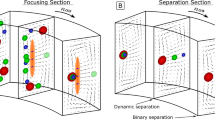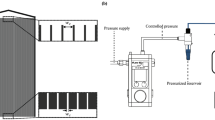Abstract
WHEN a liquid containing suspended particles of uniform density streams through a conical tube, the velocity of the particles is greatest at the apex of the cone and decreases in the direction of the base. If the tube is placed in a centrifuge with the apex pointed away from the centre of rotation, in the direction of which the liquid is made to flow, the particles acquire, in addition to the velocity due to the liquid stream, a velocity in the opposite direction owing to the centrifugal effect. If Z is the distance between the apex and the centre of rotation, R the radius of the cone at the distance L from the apex, V the volume of liquid passing across any section of the tube in unit time, and x the distance from the centre of rotation, then the streaming velocity ƒ over any cross-section of the tube is The velocity of the particles in the direction away from the centre of rotation, however, increases linearly with the distance from the latter. In a certain cross-section (e) the two velocities are equal for a given particle size. Particles of this size situated centripetally from e are transported in the centrifugal direction and vice versa. Thus, when dynamic equilibrium has been attained, they have been accumulated in a very short section of the tube. Other particles are similarly accumulated in sections characteristic of their sizes ; the smaller their radii (r), the nearer the centre of rotation are their planes of equilibrium. The distribution of these planes along the radius of rotation is derived from Stokes' law and the above expression for the streaming velocity : where n is number of revolutions per min., η is viscosity of liquid, S is density of particles, S' is density of suspension medium. For x = Z/3, r has a minimum value :
This is a preview of subscription content, access via your institution
Access options
Subscribe to this journal
Receive 51 print issues and online access
$199.00 per year
only $3.90 per issue
Buy this article
- Purchase on Springer Link
- Instant access to full article PDF
Prices may be subject to local taxes which are calculated during checkout
Similar content being viewed by others
Author information
Authors and Affiliations
Rights and permissions
About this article
Cite this article
LINDAHL, P. Principle of a Counter-streaming Centrifuge for the Separation of Particles of Different Sizes. Nature 161, 648–649 (1948). https://doi.org/10.1038/161648a0
Issue Date:
DOI: https://doi.org/10.1038/161648a0
This article is cited by
-
Membrane-less microfiltration using inertial microfluidics
Scientific Reports (2015)
-
Merging high-quality biochemical fractionation with a refined flow cytometry approach to monitor nucleocytoplasmic protein expression throughout the unperturbed mammalian cell cycle
Nature Protocols (2013)
-
Cell cycle synchronization of animal cells and nuclei by centrifugal elutriation
Nature Protocols (2008)
-
A quantitative method for separation of livingHydra cells
Roux's Archives of Developmental Biology (1992)
Comments
By submitting a comment you agree to abide by our Terms and Community Guidelines. If you find something abusive or that does not comply with our terms or guidelines please flag it as inappropriate.



